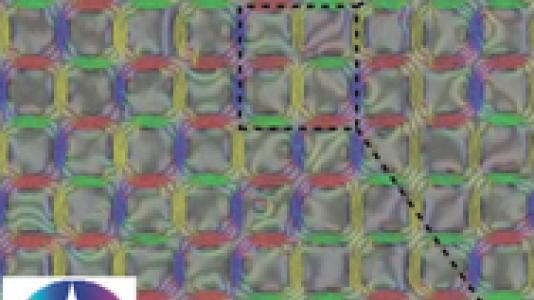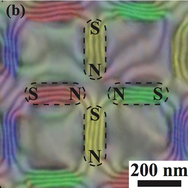
Scientific Achievement
Real space observation of magnetic monopole defects and Dirac string defects in nanoscale magnetic lattices.
Significance and Impact
Understanding and control of the behavior of nanoscale magnetic lattices will help in development of next-generation low-power magnetic logic-based devices
High-Level Research Details
Direct, high-resolution observation of magnetization in and around nanoislands of NiFe (80 x 200 nm) was performed using phase-reconstructed aberration corrected Lorentz transmission electron microscopy.
In situ behavior was studied by using magnetic force microscopy, which can be correlated with fundamental physics of strongly correlated systems.
Additional Research Details
In this research, supported by the U.S. Department of Energy’s Office of Basic Energy Sciences, we have shown the signature of magnetic induction associated with a “magnetic monopole” defect for the first time.
Some of the most exciting phenomena observed in magnetic structures result from nanoscale confinement. This can lead to emergent behavior such as frustration of magnetic spins, which occurs when the lowest energy state of the system cannot be achieved because of competing interactions between the magnetic nanostructures. This phenomenon is seen in bulk pyrochlore crystals (e.g., Dy2Ti2O7) but only at low temperatures.
By patterning nanoscale magnetic islands on a square lattice, this behavior can be easily accessed at room temperature. We fabricated such lattices composed of 200 nm NiFe (Permalloy) islands and were able to observe the frustrated behavior of these systems by using a combination of magnetic force microscopy and Lorentz transmission electron microscopy (LTEM).
For the first time, we were able to visualize the magnetic induction associated with frustration in the lattice by using our unique state-of-the-art aberration-corrected LTEM. These sites have been termed “emergent magnetic monopole defects” since they are similar to the magnetic monopoles predicted by Dirac. The visualization of the nanoscale interactions was only possible because of the high spatial resolution obtainable by aberration correction. This research is focused on understanding the fundamental physics of magnetic frustration as it provides an opportunity to exploit such novel emergent behavior under the influence of external stimuli such as temperature or magnetic field. Control of such behavior can potentially lead to low-power magnetic logic-based devices.
Research Team
Charudatta Phatak, Amanda Petford-Long, Olle Heinonen, Mihaela Tanase, Mengchun Pan, Seungbum Hong (Argonne Materials Science Division); Marc De Graef (Carnegie Mellon University)
Sponsors
U.S. Department of Energy Office of Science, Materials Science and Engineering Division
References
- C. Phatak, A. Petford-Long, O. Heinonen, M. Tanase, and M. De Graef, Phys. Rev. B, 83, 1-5 (2011).
- C. Phatak, M. Pan, A. K. Petford-Long, S. Hong, and M. De Graef, New J. Phys. 14, 075028 (2012).
Acknowledgments
This work was carried out at Argonne National Laboratory (ANL), a U.S. Department of Energy Laboratory operated under contract no. DE-AC02-06CH11357 by UChicago Argonne, LLC. We also acknowledge the use of the Center for Nanoscale Materials at ANL. MDG acknowledges DOE’s Office of Basic Energy Sciences for partial support (DE-FG02- 01ER45893). We acknowledge M. Tanase for sample preparation and E. Gulsoy for help with digital MFM image analysis.
